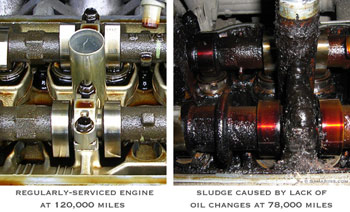Your engine is the heart of your car and to last long without problems it needs to be maintained well. Let’s look what is needed to keep your engine in a good shape. First, consider the most common causes of engine problems:
• Lack of regular oil changes
• Driving low on oil
• Overheating
• Using low quality fuel or oil
• Racing, driving only short trips, excessive idling
• Design and parts flaws
Why regular oil changes are important?
Your engine has a lot of moving and rotating parts and needs to be well lubricated. That’s the function of the engine oil. As you drive, engine oil gradually degrades. It loses its lubricating qualities and carbonizes under high temperatures. If you change you oil regularly, you keep your engine clean and well lubricated inside, see the photo. If you continue driving much longer past the regular oil interval, the friction slowly increases causing mechanical wear and the engine slowly gets contaminated with carbon deposits or sludge (in the photo). Through the engine ventilation system these carbon deposits are transferred into the engine intake and build up inside the throttle body and on the valves. This might cause lack of power, rough idle, Check Engine light and various driveability issues. If you don’t remember when you have done your last oil change, check the engine oil with the dipstick; if it looks too dirty, have the oil change done. Read here how to check engine oil: simple car maintenance checklist.
Why do you need to check your oil level?
Over time, the engine oil level drops because some amount of oil gets burned in the engine. Driving with very low oil level can cause serious engine damage. Check this photo; this engine “trew a rod” when it ran out of oil. That’s why the oil level needs to be checked regularly especially if you notice that your engine consumes oil between oil changes. Many cars have maintenance remainders that give you a warning when your next oil change is due, but a very few cars will actually warn you if the oil level drops. You still have to check the oil level manually. Car manufacturers recommend checking oil level at every fill-up. With our busy lives, this doesn’t sound realistic, but if you at least check it once a month, you might be able to catch your oil level getting low and top it up or have the oil change done. It takes just a couple minutes to check the oil level; all you need is a level spot to park your car and a clean rag to wipe out your dipstick.
Where is the oil dipstick located?
This is actually very common question. The easiest way to find it is to check your owner’s manual. You can quickly find in the maintenance section:
Maintenance » Do-It-Yourself Maintenance » Engine Compartment. Typically, you will see the map of the engine compartment that shows where the major components are located. The engine oil dipstick usually has a bright handle that says ‘Engine Oil’ on it.
Protecting your engine from overheating
The fuel burned inside the engine produces a lot of heat. Keeping the engine temperature under control is the work of the cooling system. The cooling system circulates liquid coolant (antifreeze) from the engine into the radiator installed in the front of the car where the coolant is cooled down by the air flow passing through the radiator fins.
A problem with a cooling system can cause the engine to overheat, and this can result in serious damage to the engine. One of the common problems with a cooling system is lack of coolant caused by leaks. Coolant leaks are very common in many cars. Here is an example. For this reason, it’s important to keep your engine coolant level full. Check the coolant level regularly; your owner’s manual has the directions.
Caution: Never open the radiator or the coolant overflow reservoir when the engine is hot; engine coolant is under pressure!
If you found a coolant leak in the engine compartment or on your parking spot, have it fixed before lack of coolant will cause overheating; coolant is usually green, orange or red in color. If you notice the engine temperature rising above normal, have your car checked out before the engine overheats.
Synthetic oil versus conventional mineral oil
Many newer cars require synthetic oil, as it offers better protection for the engine. The advantage of synthetic oil is that it can withstand higher temperature and can work longer without losing its lubricating qualities. Synthetic oil doesn’t get thicker at below-zero temperatures and provides better engine lubrication at a cold start. Using synthetic oil makes perfect sense if you have a low-mileage or turbo engine or often drive under severe conditions such as high temperatures, excessive load or long intervals without an oil change.
However, using synthetic oil in high-mileage engines is not always worth the extra cost. Since synthetic oil is “thinner,” a high-mileage engine filled with synthetic oil is more likely to develop leaks or run noisier.
What is the right oil change interval when using synthetic oil? This is a pretty heated debate. The synthetic oil lasts longer but what about the products of engine wear? The moving parts inside the engine still wear, whether regular or synthetic oil is used. If you drive longer between the oil changes, the products of wear mix with oil and lessen its lubricating ability. On top of this, they clog up the oil filter reducing the oil flow that further increases friction. All this means that it makes sense to keeping the oil change intervals close to what recommended by your car manufacturer even with synthetic oil.

How to maintain your engine
by
Tags:

Leave a Reply